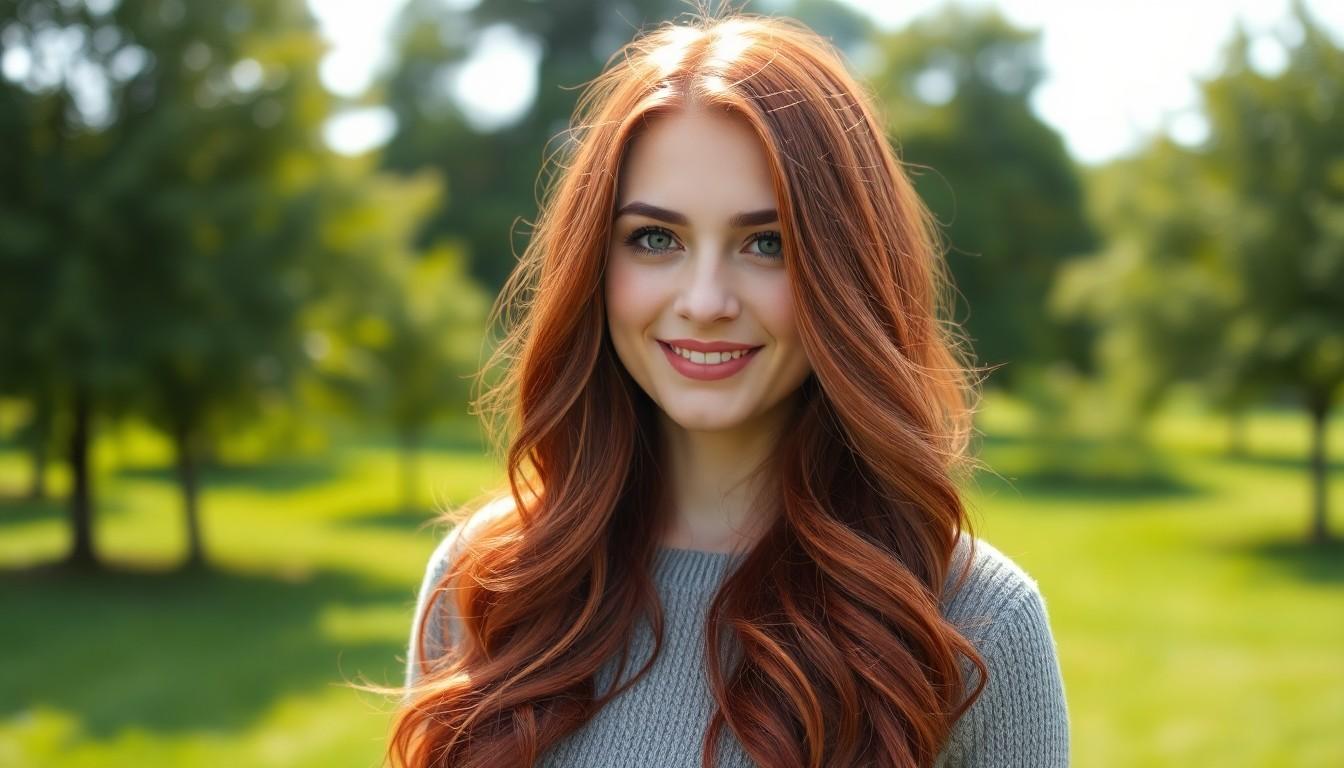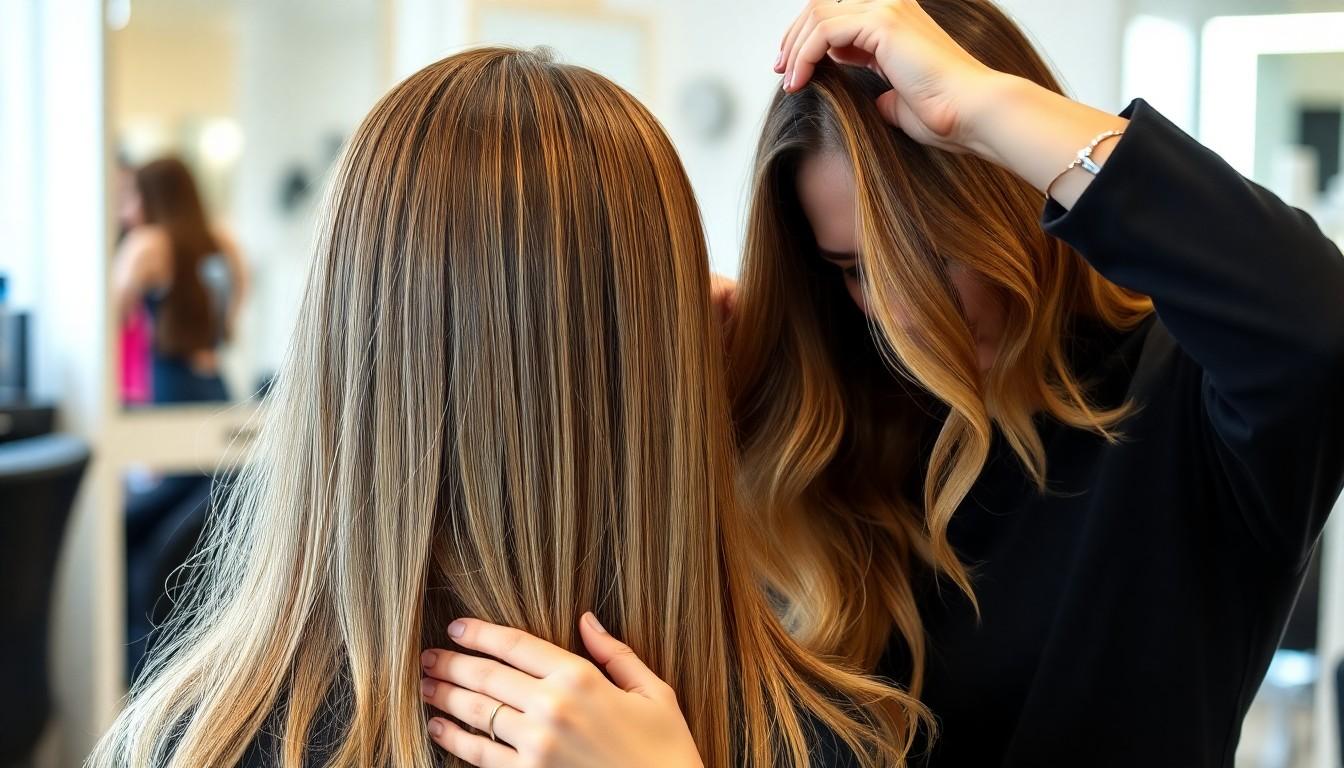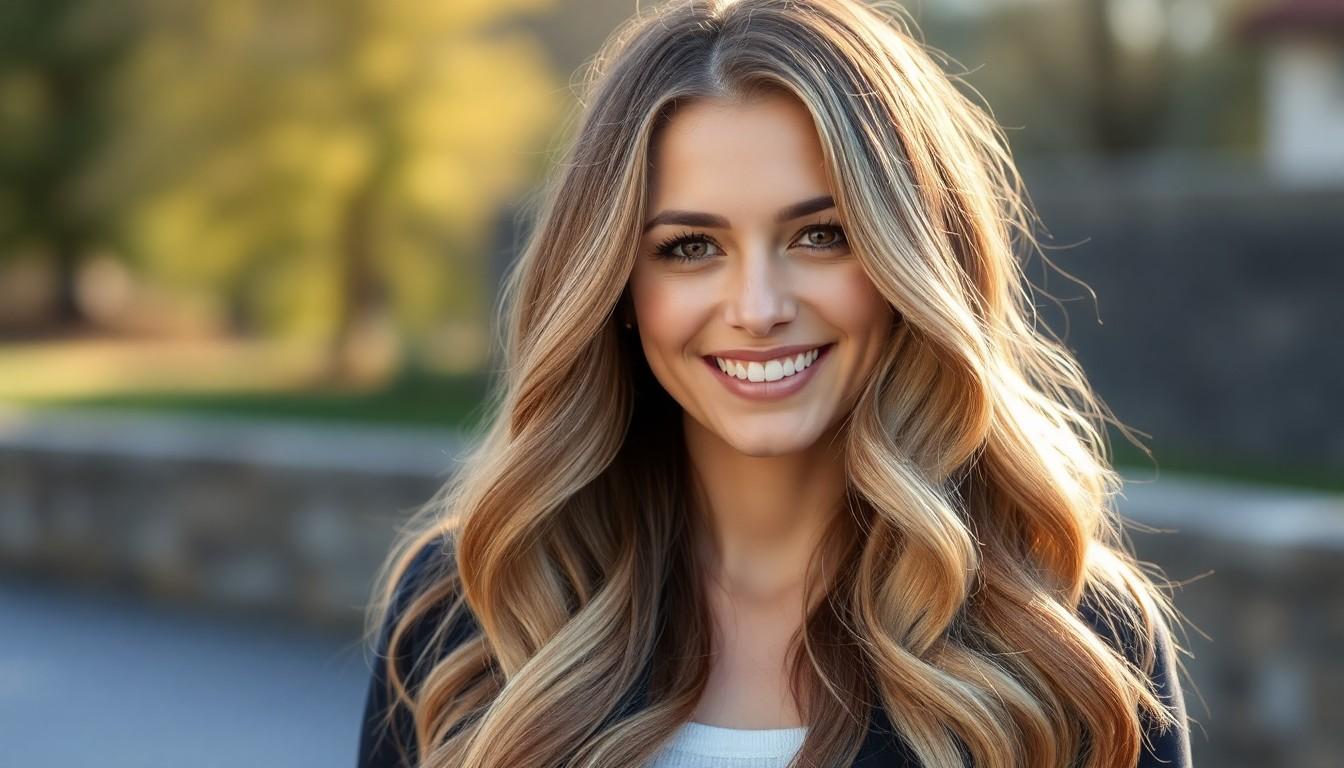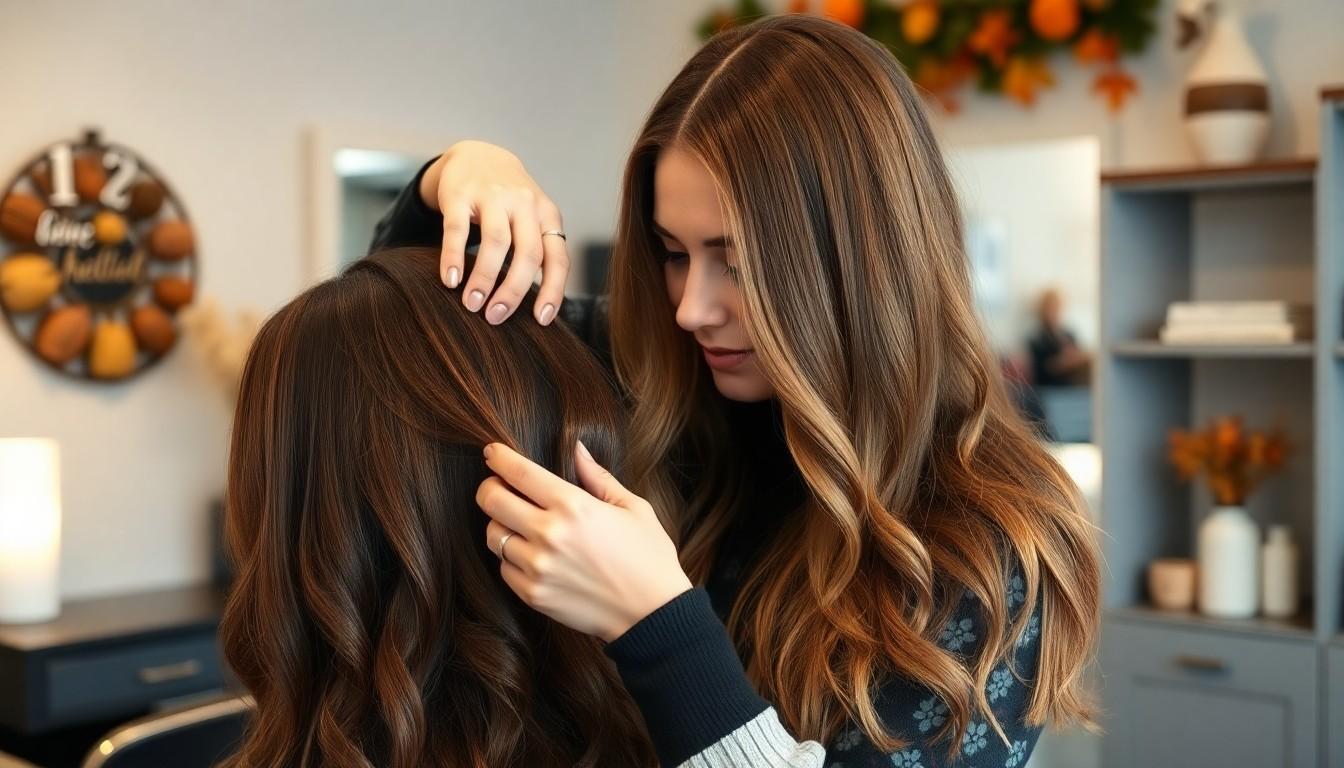Looking to add dimension to your hair without a dramatic change? Babylights and lowlights might be the perfect solution you’ve been searching for. These subtle hair coloring techniques have gained immense popularity for their ability to create natural-looking dimension and depth.
We’ll explore how babylights—those delicate, fine highlights that mimic the sun-kissed strands of children’s hair—differ from traditional highlights, and how lowlights can add richness and contrast to your overall look. Whether you’re a blonde looking for depth, a brunette seeking dimension, or someone wanting to refresh your current color, understanding these techniques will help you communicate exactly what you want at your next salon appointment.
What Are Babylights and Lowlights: Understanding the Difference
Babylights are ultra-fine highlights that mimic the natural sun-kissed dimension found in children’s hair, creating subtle brightness throughout the hair. These delicate streaks are painted on tiny sections of hair, sometimes as fine as just a few strands, resulting in a seamless, natural-looking finish. Unlike traditional highlights that can appear as chunky strips, babylights blend almost imperceptibly with your natural color for a soft, dimensional effect.
Lowlights, on the other hand, add depth and richness by incorporating darker tones into the hair. These deeper shades create shadows and contrast within your existing color, improving dimension without lightening the hair. Strategically placed lowlights can make thin hair appear fuller, add sophistication to one-dimensional color, and create a multi-tonal effect that looks incredibly natural.
The main difference between these techniques lies in their purpose and application method. Babylights lighten small sections to create brightness and mimic natural sun exposure, while lowlights darken selected strands to add depth and richness. Both techniques use foils during application, but babylights require extremely fine sectioning and precise placement to achieve their characteristic subtle effect.
For clients with light hair, babylights can add dimension without dramatically changing the overall look. Dark-haired individuals often benefit from lowlights that prevent their color from appearing flat or one-dimensional. Many skilled colorists combine both techniques in a single service to create truly customized, natural-looking results that enhance each client’s unique features.
The maintenance requirements for these techniques vary significantly. Babylights typically require touch-ups every 8-12 weeks as they grow out relatively gracefully with minimal obvious regrowth. Regular lowlights may need refreshing every 6-8 weeks, especially if they’re being used to blend gray hair or maintain a exact color balance in your overall look.
10 Benefits of Combining Babylights and Lowlights for Natural-Looking Hair

When you’re looking to enhance your hair color without committing to dramatic changes, combining babylights and lowlights offers the perfect solution. This powerful duo creates stunning results that look natural and effortless.
Enhanced Dimension and Depth
Babylights add delicate strands of brightness that mimic the sun-kissed effect found naturally in children’s hair. These ultra-fine highlights create subtle luminosity throughout your mane without appearing overly processed or artificial. Lowlights work in perfect harmony by incorporating darker shades—typically 2-3 shades deeper than your base color—creating rich depth that makes your overall color appear more ever-changing. The contrast between these lighter and darker tones creates a multidimensional effect that gives hair natural movement and visual interest even when styled simply.
Low Maintenance Color Solution
Babylights grow out beautifully with minimal noticeable regrowth lines due to their fine, subtle nature. Their seamless blending with your natural color means you can extend time between salon appointments to 8-12 weeks without obvious roots. Lowlights further enhance this low maintenance appeal by deepening your natural color rather than creating stark contrast, making the grow-out process even more forgiving. Clients appreciate fewer touch-up appointments, saving both time and money while maintaining gorgeous, dimensional color. This combined approach creates a color that evolves naturally over time rather than appearing “grown out” or requiring constant upkeep.
Creates Natural-Looking Results
Babylights perfectly imitate how the sun naturally lightens hair, creating an authentic sun-kissed appearance. Lowlights complement this effect by reinforcing your natural depth and preventing the hair from looking over-processed or artificial. Together, these techniques create dimension that mimics how hair naturally varies in tone, resulting in color that looks like you were born with it.
Adds Visual Thickness and Texture
The strategic placement of babylights and lowlights creates an optical illusion of fuller, thicker hair. Light reflects differently off varying tones, creating movement and the appearance of increased volume. Fine or thin hair especially benefits from this technique as it provides depth and dimension without compromising hair integrity.
Customizable for Every Hair Color
From blondes to brunettes to redheads, this combination technique works beautifully across the spectrum. Fair-haired clients can add warmth and depth with lowlights while keeping brightness with babylights. Darker-haired individuals can introduce subtle brightness without looking stripy or unnatural. The versatility makes this approach suitable for virtually anyone seeking natural enhancement.
Corrects Previous Color Issues
Babylights and lowlights together provide an effective solution for fixing previous color mistakes. Over-highlighted hair can be balanced with strategic lowlights to restore depth and dimension. Flat, one-dimensional color can be revitalized with subtle babylights to create movement and interest throughout the hair.
Reduces Damage Potential
Due to their fine, delicate nature, babylights require less lightener application than traditional highlighting methods. Lowlights don’t require lightening at all, further minimizing potential damage. This combined approach preserves hair health while still achieving beautiful dimensional results that more aggressive techniques might compromise.
Enhances Facial Features
Strategically placed babylights around the face brighten your complexion and draw attention to your eyes. Complementary lowlights create shadow and depth that accentuate your facial structure and features. This personalized placement creates a custom frame for your face that enhances your natural beauty.
Seasonal Adaptability
This color combination easily transitions between seasons with minor adjustments. Adding more babylights creates brightness perfect for summer months, while increasing lowlights provides warmth and richness ideal for fall and winter. The foundational technique remains consistent while allowing for seasonal tweaks without complete color overhauls.
Age-Appropriate Sophistication
Babylights and lowlights together create sophisticated dimension that flatters at any age. This technique effectively camouflages gray hair while maintaining a natural appearance that avoids the harsh, obvious look of single-process color. The multidimensional effect appears more youthful and vibrant without looking inappropriate or trying too hard.
How to Choose the Right Babylights and Lowlights for Your Hair Color

Selecting the perfect babylights or lowlights technique depends largely on your natural hair color and desired outcome. Let’s explore how these techniques can enhance different hair colors for the most flattering results.
For Blondes: Creating Sun-Kissed Dimension
Babylights offer blondes a fantastic way to enhance their natural color without creating stark contrast. These ultra-fine highlights mimic the natural sun-kissed effect seen on children’s hair, adding subtle dimension throughout blonde locks. Stylists achieve this by lightening very fine sections of hair just slightly, resulting in a soft, multi-dimensional appearance that looks completely natural.
Lowlights work wonderfully for blondes who need to balance overly bright or washed-out highlights. Adding darker tones creates necessary contrast and depth, preventing that one-dimensional look that can sometimes occur with all-over blonde color. This technique enriches the overall color palette, making blonde hair appear thicker and more textured while adding visual interest to your style.
For Brunettes: Adding Richness and Movement
Babylights aren’t just for blondes—brunettes can benefit tremendously from this subtle highlighting technique. Adding delicate, slightly lighter strands throughout brown hair softens harsh lines and creates a beautifully blended appearance. These fine highlights add a touch of natural-looking dimension that catches the light without making a dramatic color change, perfect for brunettes wanting subtle enhancement.
Lowlights enhance brunette hair by introducing even deeper, richer shades that create stunning contrast and depth. This technique makes brown hair appear more vibrant and textured, adding visual movement that can bring flat color to life. Brunettes particularly benefit from combining lowlights with subtle highlights, creating a multi-tonal effect that adds remarkable dimension and richness to darker hair colors.
For Redheads: Achieving Natural Vibrancy
Babylights help redheads enhance their vibrant color with subtle, natural-looking highlights that complement their unique shade. This technique softens any harsh lines in red hair, creating a more blended, sun-kissed appearance that looks organically beautiful. Red hair of all types benefits from babylights, which add flattering dimension while maintaining the integrity of those gorgeous copper and auburn tones.
Lowlights balance the brightness of red hair by introducing deeper, cooler tones that add sophisticated depth and dimension. This technique prevents red hair from appearing too one-dimensional or overly bright, enriching the natural color with complementary darker shades. The result is more textured, vibrant red hair with enhanced movement and visual interest that showcases the complexity of this stunning hair color.
When selecting between these techniques, consider what you’re hoping to achieve. Babylights create subtle, natural-looking dimension that mimics sun-kissed hair, while lowlights add more noticeable contrast and depth. Both techniques work well across all hair types, with babylights creating the illusion of fuller hair and lowlights adding richness and movement that enhances your natural color.
5 Popular Babylights and Lowlights Techniques Used by Professional Stylists

Professional stylists have mastered several techniques to create stunning babylights and lowlights that enhance natural hair color. These methods vary in application but all aim to create dimension and depth that looks effortlessly natural.
Fine Foiling Method
The Fine Foiling Method stands as the gold standard for creating authentic babylights. This technique involves working with extremely fine sections of hair and minimal foil separations, allowing for precise control over color placement. Stylists select micro-fine woven highlights, particularly around the hairline and parting, to mimic the natural sun-kissed effect seen in children’s hair. The delicate nature of these highlights ensures they blend seamlessly with your base color, creating that coveted subtle dimension. This method works beautifully on all hair colors—from blondes and brunettes to redheads—and offers the advantage of low maintenance as your hair grows out.
Balayage Blend Approach
The Balayage Blend Approach combines the freehand painting technique of balayage with the strategic placement of babylights or lowlights. Stylists apply color in sweeping motions through portions of the hair, creating a graduated, natural-looking transition between shades. This technique particularly excels when incorporating lowlights into the hair, as it enhances depth and dimension without creating harsh lines or obvious demarcations. Color is strategically painted onto selected sections to create a multidimensional effect that appears to have developed naturally. Many clients prefer this approach for its customizable results and the way it grows out beautifully, requiring fewer touch-up appointments.
Back Combing Technique
The Back Combing Technique offers a clever solution for achieving well-blended lowlights without harsh lines. Stylists gently backcomb sections of hair before applying the darker color, creating a diffused line of demarcation that transitions naturally from the mid-lengths to the ends. This method prevents the harsh banding effect that can occur with traditional foiling techniques. The strategic teasing of hair allows for a soft diffusion of color that melts perfectly into the base shade. This technique proves especially beneficial for those transitioning from previously highlighted hair to a more dimensional look.
Root Smudge Integration
Root Smudge Integration involves applying a shade closer to your natural color at the roots, creating a seamless transition between your natural hair and your babylights or lowlights. Stylists apply this technique to prevent the harsh grow-out line that often accompanies traditional highlighting methods. The color is strategically smudged into the root area, softening the contrast between natural regrowth and colored strands. This approach extends the life of your color service, allowing for more time between appointments while maintaining a polished, dimensional look throughout the grow-out phase.
Micro-Slicing Application
The Micro-Slicing Application technique takes precision to another level by creating ultra-thin slices of hair for color application. Stylists separate tiny sections—often no thicker than a few strands—to apply either lighter or darker color. This meticulous approach creates the most natural-looking babylights and lowlights possible, as it mimics how hair naturally lightens or varies in tone. The result delivers incredible dimension without an obvious pattern of highlights or lowlights. This technique requires important expertise and time but rewards clients with remarkably natural results that enhance rather than overshadow their base color.
Maintenance Tips: How to Keep Your Babylights and Lowlights Looking Fresh

Maintaining the vibrancy and dimension of your babylights and lowlights requires proper care and attention. With the right products and maintenance schedule, you can extend the life of your color and keep your hair looking salon-fresh between appointments.
Recommended Hair Care Products
- Sulfate-Free Shampoo and Conditioner are essential for preserving your color investment. Products like the Elements Xclusive Colour Shampoo & Conditioner protect your babylights and lowlights from fading prematurely while maintaining hair health.
- Heat Protectant Products shield your color-treated hair from thermal damage. IdHAIR Me Blow Dry Cream provides excellent protection when styling with hot tools, which can otherwise accelerate color fading.
- Deep Conditioning Treatments keep your hair hydrated and prevent breakage. Regular use of Elements Xclusive Moisture Conditioner maintains the integrity of color-treated strands and enhances the overall appearance of your babylights and lowlights.
- UV Protection Products defend against sun damage that can fade your color. Essentials Super Strong Hold Hair Spray offers dual benefits of style hold and UV protection, while Elements Xclusive 911 Rescue Spray provides additional protection for overall hair health.
Touch-Up Timeline and Strategies
- Schedule Regular Touch-Ups every 6-8 weeks to maintain the richness and dimension of your color. This timeframe prevents your babylights and lowlights from losing their intended effect while maintaining a natural grow-out.
- Focus on Subtle Application when refreshing babylights, particularly around the face frame. Avoiding intense or contrasting highlights ensures your color remains natural-looking and dimensional.
- Apply Lowlights Strategically toward the mid-lengths and ends of your hair. Blondes especially benefit from this approach as it prevents visible lines along the hairline while adding necessary depth.
- Maintain Color Balance by keeping highlight and lowlight colors within 3-4 shades of each other. This technique prevents a stripy appearance and ensures a cohesive, blended look.
- Avoid Over-Correction during maintenance appointments. Working with subtle adjustments preserves the natural-looking dimension that makes babylights and lowlights so appealing.
- Limit Heat Styling between appointments to prevent premature fading. When heat tools are necessary, always apply a quality heat protectant first to minimize damage.
DIY or Professional: When to Schedule a Salon Appointment vs. At-Home Options

When to Choose Professional Babylights
Professional babylights are worth the investment for several exact reasons. Skilled colorists possess the expertise to place ultra-fine highlights strategically throughout your hair, creating that coveted sun-kissed effect that perfectly mimics natural childhood highlights. These delicate streaks require precise technique and placement that’s difficult to achieve at home, as professionals work with extremely thin sections of hair to create seamless blending. Color customization is another important advantage, with salon experts able to select complementary shades for your skin tone and mix various tones with different oxidants to enhance the natural beauty of your babylights. The meticulous attention to detail ensures your highlights appear natural rather than striped or chunky, creating that dimensional look that grows out beautifully with minimal maintenance.
When to Choose Professional Lowlights
Lowlights benefit tremendously from professional application due to their technical complexity. Professional colorists understand how to add darker tones that create proper contrast and depth without overwhelming your natural hair color. They’re trained to balance these darker shades throughout your hair, preventing that dreaded patchy or uneven appearance that often results from DIY attempts. Salon experts excel at enriching your hair color through strategic lowlight placement, making your hair appear thicker and more textured while maintaining a natural look. Their mastery of color theory allows them to customize the perfect shade depth for your exact hair type, ensuring your lowlights enhance rather than compete with your base color.
DIY Hair Color Considerations
At-home coloring works best for simple, all-over color applications rather than dimensional techniques like babylights and lowlights. DIY box dyes can be suitable for covering gray hair or making subtle changes to your overall hair color, providing a budget-friendly option for basic color maintenance. Root touch-up kits offer an effective solution between salon appointments when you need a quick fix for growing roots. Semi-permanent color options present less risk for at-home users since they gradually fade without harsh lines of demarcation. Understanding your limitations is crucial when considering DIY color, as achieving the precision needed for natural-looking babylights or dimensional lowlights requires professional training and specialized tools that aren’t available in typical at-home kits.
Risks of DIY Babylights and Lowlights
Attempting babylights or lowlights at home carries important risks that can compromise your hair’s appearance and health. Uneven application commonly occurs with DIY attempts, resulting in chunky, striped highlights or blotchy lowlights that look obviously artificial. Incorrect color selection presents another common pitfall, as choosing shades too light or dark can create stark contrast rather than natural dimension. Overlapping color on previously treated sections often leads to breakage and important damage, requiring costly corrective services. The placement precision required for these techniques simply can’t be achieved when working on your own hair, as you can’t properly see all angles of your head. Most DIY color kits also lack the professional-grade products that salons use, resulting in potentially brassy tones or premature fading.
Making the Right Choice for Your Hair Goals
We recommend consulting with a professional colorist to determine the best approach for your exact hair needs. Bring inspiration photos to your consultation to clearly communicate your desired look and discuss realistic expectations based on your current hair condition. Professional services become particularly essential when making important changes to your hair color or when seeking dimensional techniques like babylights and lowlights. For those on a budget, many salons offer partial applications or “money piece” options that focus color around your face for maximum impact with minimum expense. Remember that professional color typically lasts longer and grows out more gracefully than DIY attempts, often making it more cost-effective in the long run even though the higher initial investment.
Celebrity-Inspired Babylights and Lowlights Looks to Show Your Stylist

Natural Dimension Look
Natural dimension created through babylights and lowlights offers a stunning effect that mimics the variations found in natural hair color. This style works particularly well for brunettes who want to maintain their natural grow-out while adding subtle brightness. Celebrity stylists often recommend this combination for clients seeking a low maintenance yet sophisticated look. Many A-list actresses opt for this technique to create depth and movement without appearing overly processed. The strategic placement of both lighter and darker strands creates a multi-dimensional effect that photographs beautifully on red carpets and in everyday life.
Caramel Lowlights Style
Caramel lowlights paired with subtle babylights create a warm, rich look perfect for fall and winter seasons. This technique works wonderfully for those with light to medium brown hair wanting to add depth and warmth. Fashion-forward celebrities frequently choose this style when transitioning from summer to autumn looks. The warm brown lowlights help tone down brighter highlights while adding a beautiful caramel dimension throughout the hair. Stylists achieve this look by carefully selecting complementary shades that enhance the natural undertones in the hair.
Balayage with Strategic Lowlights
Balayage techniques enhanced with precisely placed lowlights deliver a sun-kissed appearance with incredible depth. This combination maintains a natural look while still providing the brightness of highlighted hair that many celebrities favor. Red carpet events often showcase this versatile style that works across various hair lengths and textures. The balayage application gives that effortless, grown-out look while the lowlights prevent the hair from appearing flat or one-dimensional. A-list celebrities often request this technique for its ability to look natural both on and off camera.
Textured Styling for Maximum Impact
Textured styling dramatically showcases the beauty of babylights and lowlights compared to straight styles. Waves and curls help the different color dimensions catch the light, creating movement and visual interest throughout the hair. Celebrity hairstylists frequently recommend loose waves to clients who have invested in babylights and lowlights. The interplay between lighter and darker strands becomes more apparent with textured styling, maximizing the impact of these subtle coloring techniques. Many red carpet looks feature this combination of color technique and styling to create head-turning, dimensional hair.
The Cost Breakdown: What to Expect When Getting Babylights and Lowlights

Babylights Pricing
Babylights offer a subtle, natural-looking highlighting effect that mimics sun-kissed strands, but this precision comes at a price. The cost for these delicate highlights typically ranges from $55 to $350, depending on several factors including salon location and stylist expertise. Most clients can expect to pay between $100 to $200 for a standard babylights service, with higher-end salons charging premium rates for their specialized techniques. Hair length significantly impacts the final price, as longer hair requires more product and time to achieve those fine, natural-looking streaks.
Lowlights Investment
Lowlights create depth and dimension by adding darker shades to your hair, complementing your base color beautifully. Pricing for lowlights generally starts at $75 and can reach $300 or more, particularly when you’re working with an experienced colorist at a prestigious salon. The extent of your lowlights treatment will influence the cost—partial lowlights cost less than full-head applications. Salon professionals charge based on the complexity and time required to create the perfect balance of darker tones throughout your hair.
Combined Services Costs
Pairing babylights with lowlights creates stunning dimension, but this combination treatment naturally comes with a higher price tag. The combined service typically falls between $75 to $300+, reflecting the additional time, product, and expertise required. Full-head treatments incorporating both techniques will sit at the higher end of this range, especially for longer hair types. Many salons offer package deals for combination services, so it’s worth asking about special pricing when booking your appointment.
Factors Influencing Your Total Bill
Several key elements determine exactly how much you’ll pay for your babylights and lowlights service. Hair length plays a major role—longer locks require more color product and styling time, increasing the overall cost. Salon reputation and location significantly impact pricing, with urban and high-end establishments charging premium rates for their services. Your stylist’s experience level directly affects the price, as master colorists command higher fees for their specialized skills. The complexity of your desired look also influences the final cost—more intricate color patterns or color correction work will require additional time and resources.
Seasonal Adjustments: Adapting Your Babylights and Lowlights Throughout the Year

Fall and Winter Transformations
Fall and winter call for richer, warmer tones in your hair color palette. During these cooler months, we recommend incorporating deeper lowlights in shades like mahogany or chestnut brown to create a cozy, dimensional look. These richer tones complement the seasonal shift perfectly, adding warmth when daylight hours decrease. Professional colorists often suggest slightly darker highlights and lowlights during winter months since skin tones tend to be paler, preventing your face from appearing washed out against your hair color. The contrast between your hair and complexion creates a flattering frame that enhances your natural beauty during the cooler seasons.
Spring and Summer Refreshes
When warmer weather arrives, lightening your babylights and adjusting your lowlights can create that coveted sun kissed effect. Lighter shades like caramel or toffee lowlights provide a beautiful contrast that mimics natural summer lightening. Babylights can be placed more prominently around the face to frame your features with brightness, similar to how the sun would naturally lighten these areas. This technique effectively captures the essence of summer without requiring harsh all-over color processing. The strategic placement of lighter tones throughout your hair creates dimension that looks entirely natural and effortlessly beautiful.
Adapting Color Intensity with the Seasons
Color intensity should adjust with the changing seasons to maintain harmony with your overall appearance. Professional hairstylists can customize babylight and lowlight shades to complement both the season and your skin tone. Summer treatments might feature vibrant, brighter tones that reflect the energy of the season. Conversely, fall and winter applications typically incorporate deeper, more subdued shades that enhance your hair’s natural beauty while complementing cooler seasonal skin tones. These subtle modifications ensure your hair color remains flattering year-round while still appearing naturally dimensional.
Professional Guidance for Seasonal Transitions
We strongly recommend consulting with professional stylists when transitioning your babylights and lowlights between seasons. Expert colorists possess the knowledge to gradually shift your color palette without dramatic changes that might damage your hair or appear unnatural. Their expertise allows for customized color applications that specifically complement your skin tone, personal style, and the current season. Professional guidance ensures you’ll achieve a flattering, natural-looking result that enhances your appearance regardless of the time of year. Skilled colorists can create a maintenance schedule that allows your color to evolve seamlessly with the seasons.
Common Mistakes to Avoid When Getting Babylights and Lowlights
Babylights and lowlights offer stunning dimension that enhances your natural beauty when done correctly. We’ve explored how these techniques create subtle yet impactful results for all hair colors through professional application and proper maintenance.
Remember that these sophisticated coloring methods require expertise to achieve that perfect sun-kissed glow or rich depth. Whether you’re embracing seasonal changes or drawing inspiration from celebrity trends, the right combination will elevate your look while remaining wonderfully low-maintenance.
Trust your journey to skilled professionals who understand the nuances of these techniques. With proper care and regular touch-ups, your dimensional color will continue to turn heads while growing out beautifully. Your perfect hair color awaits—subtle yet stunning and uniquely yours.
Frequently Asked Questions
What are babylights in hair coloring?
Babylights are ultra-fine highlights that mimic the natural, sun-kissed look of children’s hair. These delicate streaks are placed strategically throughout the hair in very thin sections, creating subtle brightness that blends almost imperceptibly with your natural color. Unlike traditional highlights that can appear chunky, babylights offer a seamless, natural-looking dimension.
How do lowlights differ from highlights?
Lowlights add darker tones to your hair instead of lighter ones. While highlights brighten by lifting color, lowlights create depth and richness by incorporating deeper shades. They enhance dimension without lightening the hair and can make thin hair appear more voluminous. Lowlights are perfect for adding contrast and preventing hair from looking flat or one-dimensional.
How long do babylights and lowlights last?
Babylights typically need touch-ups every 8-12 weeks, while lowlights may require refreshing every 6-8 weeks. Both techniques grow out more naturally than traditional coloring methods, resulting in less noticeable roots. The exact maintenance schedule depends on your hair growth rate, desired look, and how well you care for your colored hair with proper products.
What are the benefits of combining babylights and lowlights?
Combining these techniques creates a multidimensional effect with enhanced depth. This pairing offers several benefits: a more natural-looking result, lower maintenance as both grow out beautifully, potential correction of previous color issues, reduced damage compared to all-over color, and customized enhancement of facial features. The combination works across different hair colors and can be adapted seasonally.
Can babylights and lowlights work for all hair colors?
Yes, babylights and lowlights can be customized for all hair colors. Blondes benefit from subtle dimension and depth to prevent a washed-out appearance. Brunettes can achieve vibrancy with babylights and richness with lowlights. Redheads can use these techniques to enhance their unique shades while maintaining natural-looking results. A professional colorist can tailor these techniques to your specific hair color.
How much do babylights and lowlights cost?
Babylights typically range from $55-$350, with most clients paying $100-$200. Lowlights generally start at $75 and can reach $300+. Combining both techniques costs between $75-$300+. Pricing varies based on hair length, salon reputation, geographic location, and stylist expertise. Additional services like toning or conditioning treatments may increase the total cost.
Should I get babylights and lowlights done professionally?
Professional application is highly recommended for both techniques. Skilled colorists have the expertise to achieve the precise placement needed for natural-looking results. DIY attempts often result in uneven application, incorrect color selection, and potentially damaging mistakes. The investment in professional services ensures proper technique, customized color selection, and healthier hair results.
How should I maintain my babylights and lowlights?
Use sulfate-free color-protecting shampoos and conditioners. Apply heat protectants before styling and limit heat tool usage. Schedule regular deep conditioning treatments to maintain hydration. Get touch-ups every 6-8 weeks to maintain color richness. Use purple or blue shampoo (for blondes) to prevent brassiness. Protect your hair from chlorine and excessive sun exposure to extend color longevity.
How should I adjust my babylights and lowlights seasonally?
For fall and winter, incorporate richer, warmer tones like mahogany or chestnut. In spring and summer, opt for lighter shades such as caramel or honey. Adjust the intensity of your colors to complement seasonal skin tone changes. Consult with your stylist about seamless seasonal transitions that maintain harmony with your overall appearance while ensuring your color stays fresh and flattering.
What techniques do professionals use for babylights and lowlights?
Professionals use several techniques: the Fine Foiling Method for authentic babylights; Balayage Blend for natural transitions; Back Combing for well-blended lowlights; Root Smudge Integration to prevent harsh grow-out lines; and Micro-Slicing for the most natural results. Each method requires precision and customization to achieve a dimensional look that enhances your natural hair color without appearing artificial.







